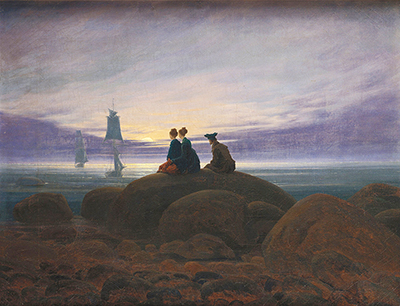Caspar David Friedrich created a huge impact on European art with his truly unique approach to landscape painting, using figures in the foreground as well as religious-based symbolism. This biography tracks his path to worldwide success.
The 5th of September, 1774, marked the arrival of baby Caspar, and he would spend the rest of the 18th century forming his technical skills that would lay behind one of the most signficant German artists in history. He was born in Greifswald, a small town which resides in modern-day Germany. This region had been under the influence of different nations in and around his lifetime, and some of this instability would be reflected in his work.
Friedrich would study in the Danish capital, Copenhagen, up until his mid twenties and would then move to Dresden once his studies had been completed. His father, Adolf Gottlieb Friedrich, chose to raise the family of ten children in a particularly formal style, making use of the Lutheran belief system which was common in that part of Europe at that time. His father came from a working-class background, being involved in several different trades. Because it was as far back as the late 18th century, some question marks still remain about his family life, some sources suggest they all received private teachings, whilst others suggest otherwise.
Friedrich's work had a sombre atmosphere on many occasions and perhaps this was influenced by his earliest brish with tragedy - the death of his mother, Sophie, at which point he was aged just seven. He would then lose two sisters and a brother in the decade the followed, although this was much more frequent during this period than it would be today in Europe. That explains why large families were very much the norm back then.
Friedrich studied the techniques of art from a fairly early age, including at the University of Greifswald. He learnt drawing skills and also spent time in the outdoors, working en plein air. Perhaps this time would inspire his concentration on landscape painting which would dominate much of his career. His teachings also included theories around nature and religion and how they were intertwined. Again, elements of this worked it's way into his most well known artistic style. He then moved from his hometown to Copenhagen where sculpture made its way into his thinking for the first time, as well as the genre of still life.
In Copenhagen the artist would discover inspiration from different styles of literature and also come into significant exposure from some of the great Dutch landscape artists of the 17th century. In these years before the modern media, many artists would have to make the effort to study art in person rather than reading about it or looking at accurate photographs of past artwork.
The artist's experimentations with different mediums continued after his move to Dresden in 1798. He would add the likes of etching, printmaking and woodcut artwork into his skillset, perhaps inspired by one of the greatest contributors to these techniques, and a fellow German, Albrecht Durer. His brother worked as a carpenter and he would have obtained some knowledge directly from him about different types of materials and how to work with them. Rembrandt van Rijn was another famous European artist who became involved in each of these different art forms and found advantages with each.




